Physical Address
304 North Cardinal St.
Dorchester Center, MA 02124
Numerous primary tumors and pseudotumors of soft tissues contain a variable number of spindle cells. In this chapter the authors will discuss only those lesions composed exclusively or predominantly of spindle cells that develop in adult patients and for which the spindle cell component is a key diagnostic feature. Some spindle cell tumors are discussed elsewhere in this book ( Table 3.1 ), if their clinical presentation is restricted to a particular anatomic area with a dedicated chapter (e.g., skin, gastrointestinal tract, or lower genital tract) or if they are better characterized by a prominent histologic feature other than their spindle cell morphology (e.g., myxoid stroma; prominent inflammation; biphasic or mixed appearance; or an adipocytic, vascular, or chondro-osseous line of differentiation). In addition, spindle cell tumors that arise exclusively or substantially more frequently in children are described in Chapter 4 .
| Tumor Type | Chapters Where Discussed |
|---|---|
| Angiomyofibroblastoma | 17 |
| Angiosarcoma, spindle cell type | 13 |
| Atypical fibroxanthoma, spindle cell type | 15 |
| Benign fibrous histiocytoma and variants | 15 |
| Calcifying aponeurotic fibroma | 4 |
| Cellular angiofibroma | 17 |
| Cranial fasciitis | 4 |
| Deep (“aggressive”) angiomyxoma | 5 and 17 |
| Dendritic cell neurofibroma | 15 |
| Dermal nerve sheath myxoma | 5 and 15 |
| Dermatofibrosarcoma protuberans | 15 |
| Dermatomyofibroma | 15 |
| Ectopic hamartomatous thymoma | 9 |
| Extraskeletal mesenchymal chondrosarcoma | 14 |
| Extraskeletal myxoid chondrosarcoma | 5 |
| Extraskeletal osteosarcoma | 7 and 14 |
| Fibroblastic reticular cell sarcoma | 10 |
| Fibromatosis colli | 4 |
| Fibrous hamartoma of infancy | 4 |
| Follicular dendritic cell sarcoma | 10 |
| Gastrointestinal stromal tumor | 16 |
| Gardner fibroma | 4 |
| Giant cell fibroblastoma | 15 |
| Hemosiderotic fibrolipomatous tumor | 12 |
| Hyaline fibromatosis | 4 |
| Hybrid schwannoma/perineurioma | 15 |
| Infantile digital fibroma | 4 |
| Infantile fibrosarcoma | 4 |
| Infantile myofibromatosis | 4 |
| Infantile rhabdomyofibrosarcoma | 4 |
| Interdigitating dendritic cell sarcoma | 10 |
| Juvenile nasopharyngeal angiofibroma | 4 |
| Kaposi sarcoma | 13 |
| Kaposiform hemangioendothelioma | 13 |
| Lipofibromatosis | 4 and 12 |
| Melanotic neuroectodermal tumor of infancy | 9 |
| Myxofibrosarcoma | 5 and 7 |
| Myxoid liposarcoma | 5 and 12 |
| Ossifying fibromyxoid tumor | 5 and 6 |
| Pilar leiomyoma | 15 |
| Plexiform fibrohistiocytic tumor | 11 |
| Plexiform fibromyxoma | 16 |
| Primitive myxoid mesenchymal tumor of infancy | 4 |
| Rhabdomyoma, fetal | 4 |
| Rhabdomyosarcoma, embryonal | 8 |
| Rhabdomyosarcoma, spindle cell (in children) | 4 |
| Solitary circumscribed neuroma | 15 |
| Spindle cell hemangioma | 13 |
| Storiform collagenoma | 15 |
| Superficial acral fibromyxoma (digital fibromyxoma) | 15 |
| Superficial angiomyxoma | 5 and 15 |
Spindle cell tumors of soft tissue are often a source of diagnostic problems for surgical pathologists. The most common issues include (1) distinguishing a nonmesenchymal malignant spindle cell neoplasm (e.g., spindle cell carcinoma) from a true sarcoma, (2) discriminating between a benign spindle cell lesion and a malignant one, and (3) classifying (i.e., typing and subtyping) and grading a spindle cell sarcoma. Some particular histologic features (myxoid stroma, prominent inflammatory infiltrate, degenerative changes) may complicate the differential diagnosis. Ancillary techniques, particularly immunohistochemistry and molecular genetics, may be of great help in resolving many diagnostic dilemmas. However, it should be stressed that in many situations the diagnostic approach should be mainly based on knowledge of the relative frequencies of different tumor types and subtypes, an appropriate consideration of the clinical context, and a correct interpretation of morphologic features.
It may not be possible to classify with certainty a subset of spindle cell lesions, both benign and malignant, into established diagnostic categories. In such situations, good communication with the clinical team is mandatory. A descriptive diagnosis that conveys all available information (e.g., status of excision margins, presence of aggressive features, probable line of differentiation, “most likely” diagnosis in that particular clinical context) is usually clinically very helpful and allows for most appropriate patient management.
Exclude nonmesenchymal spindle cell tumors (especially spindle cell carcinoma and spindle cell melanoma)
Classify the tumor, if possible
Determine if the tumor is benign or malignant
If the tumor is a sarcoma, provide the histologic grade, if appropriate for the tumor type
Provide clinically relevant information even when the tumor cannot be classified (status of excision margins, probable line of differentiation, presence of aggressive features, most likely diagnosis)
Spindle cell tumors account for approximately one-third of all soft tissue tumors that occur in adults. Benign lesions are more common than malignant tumors in this histologic group, among which cutaneous benign fibrous histiocytoma is by far the most frequent example (see Chapter 15 ).
Besides the obvious need for clinicopathologic integration for appropriate practice, relatively simple clinical parameters, such as patient age, gender, and anatomic location, can be useful for the diagnosis of some lesions with characteristic clinical or anatomic presentations. Usually, these parameters are helpful in narrowing down a wide differential diagnosis. Occasionally, however, a lesion being considered does not seem to fit the clinical context; such unusual presentations require careful reassessment of the case, integrating all the available information, and, ideally, evaluation by a multidisciplinary team to make sensible decisions for the management of the patient.
Following are some trends in the presentation of soft tissue tumors according to some of these basic clinical parameters:
Patient age. Nodular fasciitis, fibromatoses, synovial sarcoma, and dermatofibrosarcoma protuberans (DFSP) most often arise in young adults, whereas solitary fibrous tumor (SFT), spindle cell lipoma, leiomyosarcoma, angiosarcoma, spindle cell (sarcomatoid) carcinoma, and spindle cell melanoma usually occur in adults 40 years of age or older. Some benign tumors (e.g., benign fibrous histiocytoma, neurofibroma, and schwannoma) may occur at any age.
Previous medical history. For some tumor types, the presence of a particular personal or family medical history, or associated lesions, is significant. A brief summary of some of the associations that may be observed with spindle cell tumors is provided in Box 3.1 .
Trauma: nodular fasciitis and pseudosarcomatous myofibroblastic proliferation (postoperative spindle cell nodule)
Neurofibromatosis type 1: neurofibroma, GIST, MPNST
Neurofibromatosis type 2: multiple schwannomas, vestibular schwannoma
Schwannomatosis: multiple schwannomas
Carney complex: melanotic schwannoma
Pregnancy: abdominal fibromatosis
Familial adenomatous polyposis: desmoid fibromatosis, Gardner fibroma
Diabetes: palmar fibromatosis, nuchal-type fibroma
Alport syndrome: esophageal leiomyomatosis
HIV infection, transplantation, immunodeficiency: Epstein-Barr virus–associated smooth muscle neoplasm, Kaposi sarcoma
Chronic lymphedema: angiosarcoma
Radiation therapy: desmoid fibromatosis, angiosarcoma, MPNST, unclassified spindle cell sarcoma
GIST , Gastrointestinal stromal tumor; HIV , human immunodeficiency virus; MPNST , malignant peripheral nerve sheath tumor.
Tumor depth and anatomic location. Tumor depth and location are often important clues to the diagnosis. Although almost every tumor can arise at any location, some tumors have a tendency to occur at specific locations, and others show a relatively restricted anatomic distribution. The preferential locations of some tumor types are shown in Table 3.2 .
| Tumor Type | Location |
|---|---|
| Pseudosarcomatous myofibroblastic proliferation | Urinary tract |
| Intranodal palisaded myofibroblastoma | Inguinal lymph nodes |
| Fibroma of tendon sheath | Hand and foot |
| Nuchal fibroma | Back of neck |
| Elastofibroma | Scapular area |
| Solitary circumscribed neuroma | Face |
| Spindle cell lipoma | Upper back, shoulder, neck |
| Superficial fibromatoses | Palmar, plantar, and penile areas |
| Gastrointestinal stromal tumor | Intraabdominal |
| Dedifferentiated liposarcoma | Retroperitoneum, paratesticular |
| Spindle cell angiosarcoma | Head and neck (especially face and scalp) |
| Spindle cell rhabdomyosarcoma | Paratesticular, head and neck |
| Biphenotypic sinonasal sarcoma | Nasal cavity and paranasal sinuses |
In spindle cell tumors the important morphologic features to evaluate on hematoxylin and eosin–stained sections are similar to those for other mesenchymal neoplasms, including the following:
Architectural arrangement of the tumor cells (growth pattern): long or short fascicles, whorls, sheets, or haphazard architecture
Interface between tumor and adjacent tissues: pushing/expansile or infiltrative borders
Amount and type of extracellular matrix: prominent, scant, or inconspicuous; collagenous, hyalinized, or myxoid
Intratumoral vascularity: well-developed or inconspicuous; muscular thick-walled or thin-walled vessels, hyalinized vessel walls, branching (hemangiopericytoma [HPC]-like) vessels
Presence of tumor necrosis
Cytomorphology: long or short spindle cells, uniformity or pleomorphism, amount and quality of the cytoplasm, nuclear features, degree of atypia
Mitotic activity
The growth pattern and cytomorphology are key features to help determine the line of differentiation of a spindle cell neoplasm. Infiltrative borders, tumor necrosis, atypical or hyperchromatic nuclei, and mitotic activity may or may not be indicative of malignancy, and they should be interpreted according to the line of differentiation and other features of the lesion. For example, any mitotic activity in a smooth muscle neoplasm of deep soft tissue or in a neurofibroma is usually indicative of a malignant diagnosis, whereas this is not true for myofibroblastic or “fibrohistiocytic” lesions.
Immunohistochemistry plays a critical role in the diagnosis of spindle cell lesions, both to define lines of differentiation and to identify the expression of proteins that result from molecular genetic alterations specific to particular tumor types. These techniques have essentially replaced ultrastructural studies performed with electron microscopy for the diagnosis of soft tissue tumors, because of widespread availability, ease of application, rapid turnaround time, and cost effectiveness. General aspects of the application of immunohistochemistry for classification of soft tissue tumors are discussed in Chapter 1 ; the particular immunohistochemical expression patterns are described in the context of each individual tumor type throughout this and the other chapters. Cytogenetic and molecular genetic techniques are also very useful for the diagnosis of soft tissue lesions; they are presented when appropriate for each lesion individually, as well as in some detail in Chapter 18 .
Before considering a final diagnosis of mesenchymal spindle cell tumors, which are relatively infrequent, several nonmesenchymal mimics should be carefully excluded. Among them, spindle cell carcinoma and spindle cell melanoma are the most common, requiring a high degree of suspicion to avoid pitfalls in certain clinical settings. Nonmesenchymal neoplasms that may show spindle cell morphology are listed in Box 3.2 . Dendritic cell tumors are discussed in Chapter 10 . The most frequently encountered examples are discussed briefly.
Spindle cell carcinoma
Spindle cell/desmoplastic melanoma
Spindle cell/desmoplastic mesothelioma
Others
Paraganglioma
Gliosarcoma (metastasis)
Extracranial meningioma
Myeloid sarcoma (extramedullary myeloid tumor)
Interdigitating dendritic cell sarcoma
Mast cell neoplasms (systemic mastocytosis, mastocytoma, mast cell sarcoma)
Spindle cell carcinoma (sarcomatoid carcinoma, including spindle cell squamous cell carcinoma) can occur at virtually any anatomic site. It generally affects middle-aged to elderly adults. Among the most common anatomic sites are sun-exposed skin (face and scalp), lips, upper and lower respiratory tract (mouth, pharynx, larynx, lung), upper and lower digestive tract (esophagus, anal canal), thyroid, breast, urinary tract (urinary bladder, kidney, ureter), and genital tract (endometrium, vulva, penis). Sarcomatoid carcinoma can be encountered in soft tissue in two situations: either as a metastatic deposit (especially from kidney or lung) or as a locoregional extension of a known (or unknown) carcinoma. Thus pertinent previous medical history is crucial. Most sarcomatoid carcinomas are squamous in nature, but adenocarcinomas and other carcinoma types may also occasionally develop a poorly differentiated spindle cell component. The spindle cell growth pattern is usually present de novo but may also appear only at the time of local and/or distant recurrence, sometimes following radiation therapy.
Histologically, most sarcomatoid carcinomas resemble undifferentiated spindle cell/pleomorphic sarcomas ( Fig. 3.1 ), although they may also display storiform, fibrosarcoma-like, leiomyosarcoma-like, nodular fasciitis–like, or HPC-like growth patterns. Foci of heterologous differentiation (such as chondrosarcomatous, osteosarcomatous, rhabdomyosarcomatous, liposarcomatous, or angiosarcomatous elements) may occasionally occur (e.g., in Müllerian carcinosarcoma). Detection of better differentiated, epithelial-like areas and/or an in situ component is crucial to make a proper diagnosis.
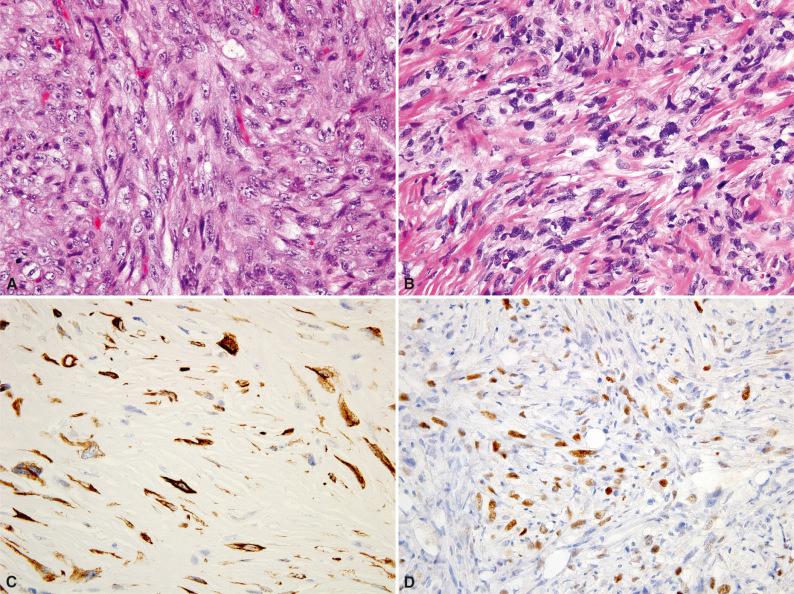
By immunohistochemistry, spindled tumor cells in sarcomatoid squamous cell carcinomas often at least focally express broad-spectrum keratins (e.g., MNF116 or AE1/AE3) (see Fig. 3.1C ), high-molecular-weight keratins (e.g., clone 34βE12, CK5 or CK5/6), as well as p63 (see Fig. 3.1D ). For sarcomatoid carcinomas of visceral sites, it is often necessary to use multiple broad-spectrum keratin antibodies before detecting a positive result. Some sarcomatoid carcinomas can be negative for keratins but may show some reactivity for epithelial membrane antigen (EMA) or p63, which can also be helpful in appropriate clinical settings. Vimentin, which is expressed in both sarcomas and sarcomatoid carcinomas, is not diagnostically useful.
Sarcomatoid carcinoma, especially in visceral organs and sun-exposed skin, should be considered before a mesenchymal tumor is diagnosed
Epithelial-like areas or an in situ component facilitates the diagnosis but may be completely absent
Even focal expression of keratins, p63, or epithelial membrane antigen can help support the diagnosis
Multiple broad-spectrum keratin antibodies may be required
Vimentin is not specific for mesenchymal tumors and is therefore not useful in differential diagnosis
As for spindle cell carcinoma, previous medical history is crucial for the diagnosis of spindle cell melanoma. It usually occurs in soft tissue either as a metastasis or as the extension of locally advanced melanoma. Lymph node metastasis (especially axillary or inguinal) with extracapsular extension into soft tissue is an extremely common presentation. Indeed, an axillary mass showing spindle cell morphology is most likely to be metastatic melanoma ( Fig. 3.2 ). The primary tumor may show either spindle cell or epithelioid cytomorphology. By immunohistochemistry, spindle cell melanomas are generally strongly and diffusely positive for S-100 protein and SOX10 (see Fig. 3.2C ), whereas second-line melanocytic markers, such as melan A and HMB-45, are rarely useful, being expressed in less than 10% of cases. Spindle cell melanoma can therefore easily be confused with malignant peripheral nerve sheath tumor (MPNST), as well as with synovial sarcoma, leiomyosarcoma, and undifferentiated spindle cell/pleomorphic sarcoma.
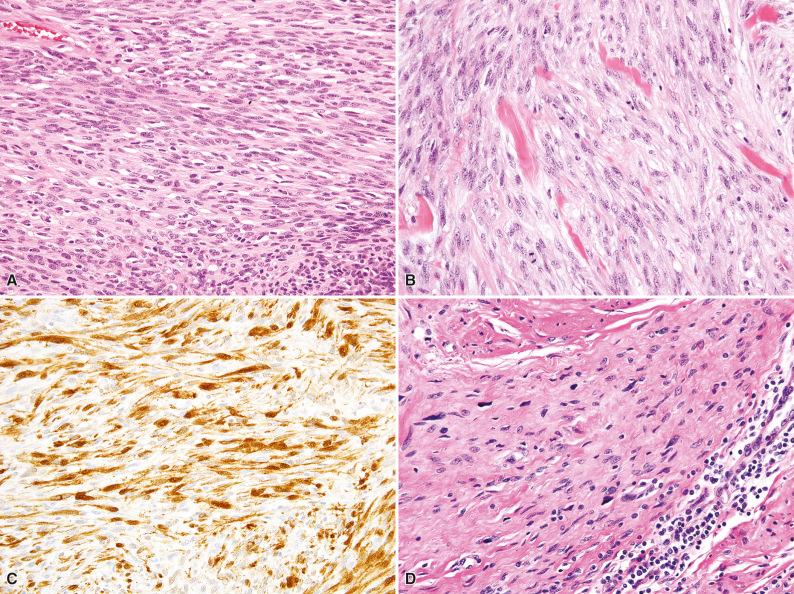
Desmoplastic melanoma can be considered a distinctive variant of spindle cell melanoma. It tends to occur in older adults (especially men), often in the head and neck area (particularly scalp) and upper back, rarely at mucosal sites (e.g., vulva or gingiva). Spindle cells tend to be arranged in vague fascicles set in an abundant collagenous matrix (see Fig. 3.2D ). Melanin production is nearly always absent. Neurotropism (i.e., tumor cells growing within and around nerves at a distance from the main tumor mass), as well as lymphoid aggregates, are frequently observed within and at the periphery of the spindle cell proliferation (see Fig. 3.2D ). An atypical or malignant melanocytic proliferation is occasionally seen at the dermal-epidermal junction, a helpful clue to diagnosis. Desmoplastic and spindle cell melanomas share the same immunoprofile, although tumor cells in desmoplastic melanoma are even more frequently negative for HMB-45 and melan A. They can be positive for smooth muscle actin and, very rarely, for keratins. Similar to spindle cell melanoma, desmoplastic melanoma may be confused with MPNST (although MPNST is usually only focally positive for S-100 protein and SOX10, in no more than 50% of cases), DFSP, leiomyosarcoma, desmoid fibromatosis, schwannoma, and neurofibroma. Perhaps the most common misdiagnosis for desmoplastic melanoma is hypertrophic scar.
Rare variants of melanoma, such as myxoid melanoma and melanomas with metaplastic changes (including foci of osteosarcomatous, chondrosarcomatous, rhabdomyosarcomatous, or liposarcomatous heterologous differentiation) are difficult to distinguish from some spindle cell sarcomas.
Metastatic melanoma, especially in the axilla and groin, should always be considered
Soft tissue or lymph node metastases may be the initial presentation
Strong and diffuse expression of S-100 protein and SOX10 is characteristic of melanoma and argues against malignant peripheral nerve sheath tumor
Second-line melanoma markers (HMB-45, melan A) are usually negative in spindle cell melanoma
Desmoplastic melanoma may be deceptively bland and is typically paucicellular, mimicking a scar
Localized sarcomatoid mesothelioma can easily be confused with a spindle cell mesenchymal neoplasm ( Fig. 3.3 ), especially MPNST, synovial sarcoma, SFT, spindle cell angiosarcoma, and undifferentiated spindle cell/pleomorphic sarcoma. Hypocellular regions of desmoplastic mesothelioma may resemble a benign fibrosing process or a desmoid tumor, whereas biphasic mesothelioma may mimic biphasic synovial sarcoma. Clues to the diagnosis of mesothelioma are as follows: previous history of asbestos exposure or radiation therapy, recurrent serosal effusions (pleural effusion or ascites), a serosal surface-based mass, and immunoreactivity of tumor cells for keratins (see Fig. 3.3C ), EMA, calretinin, WT1 (nuclear pattern), and podoplanin (D2-40), although many sarcomatoid mesotheliomas are negative for mesothelial markers (at least 60% of cases), including calretinin. In such cases, WT1 is the most sensitive mesothelial marker (see Fig. 3.3D ).
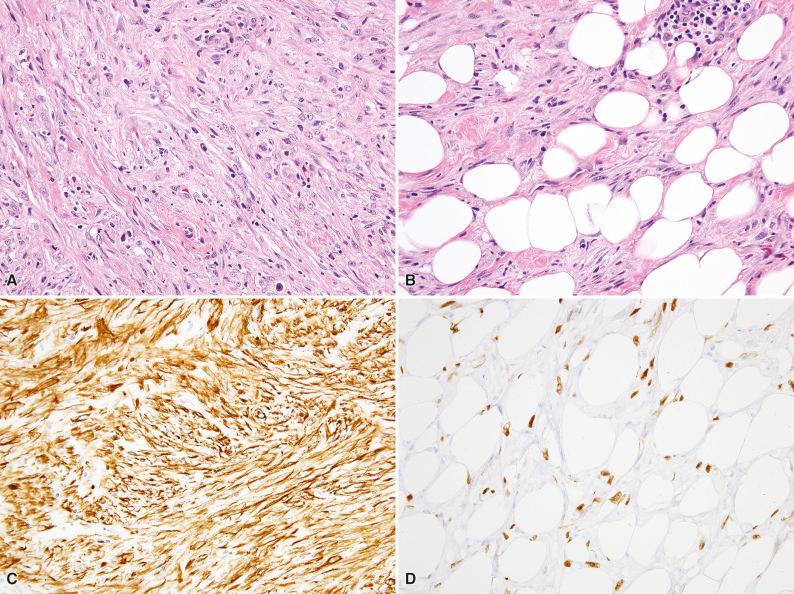
Nodular fasciitis is a self-limited pseudosarcomatous proliferation composed of fibroblasts and myofibroblasts. The morphologic spectrum of nodular fasciitis is wide. Several variants have been described under different designations depending on clinical, macroscopic, or particular microscopic features; however, all of these lesions show some overlapping histologic appearances due to their shared myofibroblastic nature. Nodular fasciitis is also discussed in Chapter 4 .
Nodular fasciitis predominates in young to middle-aged adults (20 to 40 years of age) with no gender predilection. It most often occurs as a solitary, small (<2 to 3 cm), sometimes painful subcutaneous nodule that develops rapidly, often in less than 4 to 8 weeks. The anatomic distribution is wide, but the lesion most commonly arises in the upper extremities (40% to 50% of cases), especially the forearm, followed by the head and neck area (where it is most common in children) and the trunk wall. Nodular fasciitis is infrequent in hands and feet, and it is rare in some other sites (e.g., vulva, axilla, lymph node capsule). The depth of nodular fasciitis is variable. Most cases are subcutaneous, but approximately 10% of cases are entirely intramuscular, and a small minority arises in unusual locations such as the skin (intradermal fasciitis), periosteum (parosteal fasciitis and cranial fasciitis), joints (intraarticular fasciitis), or vessels, principally veins (intravascular fasciitis). A previous history of trauma is elicited in 10% to 20% of cases.
Nodular fasciitis is usually grossly well circumscribed, measuring less than 3 cm in diameter. In the subcutis the nodule tends to develop along fibrous septa, dissecting the adipose tissue. It may also be centered on the superficial aponeurosis (fascial-type nodular fasciitis). In deep soft tissue, especially in skeletal muscle (10% of cases), the lesion tends to be larger than its subcutaneous counterpart. On section, recently developed lesions have a myxoid appearance, whereas older lesions are more fibrous and firmer.
The histologic appearances of nodular fasciitis vary according to the age of the lesion. Early lesions are usually variably cellular, consisting of fibroblasts and myofibroblasts arranged in short irregular fascicles, sometimes with a vaguely storiform pattern, set in a loosely textured myxoid matrix (feathery pattern) or a more collagenous stroma ( Fig. 3.4 ). The cells are plump, with abundant eosinophilic, somewhat fibrillary cytoplasm, resembling cells in tissue culture or granulation tissue. Nuclei are vesicular and contain a single, often prominent nucleolus (see Fig. 3.4C ). Mitoses can be numerous and are almost always typical. The lesion tends to extend along the fibrous septa from which it arises and is often surrounded and infiltrated by numerous inflammatory elements (lymphoid aggregates, plasma cells). It may also contain numerous, centripetally oriented capillaries. Mucin pooling, cystic change, interstitial hemorrhage (extravasated erythrocytes), and small collections of intralesional histiocytes are common. Sometimes, the central part of the lesion is markedly hypocellular, contrasting with the hypercellular periphery, resulting in a zonal appearance. Long-standing lesions are less cellular and more fibrotic (see Fig. 3.4D ), containing areas of hyalinized fibrosis arranged in dense, refractile, keloid-like collagen bands (see Fig. 3.4E ). Approximately 10% of cases of nodular fasciitis contain prominent osteoclast-like multinucleated giant cells (see Chapter 11 ).
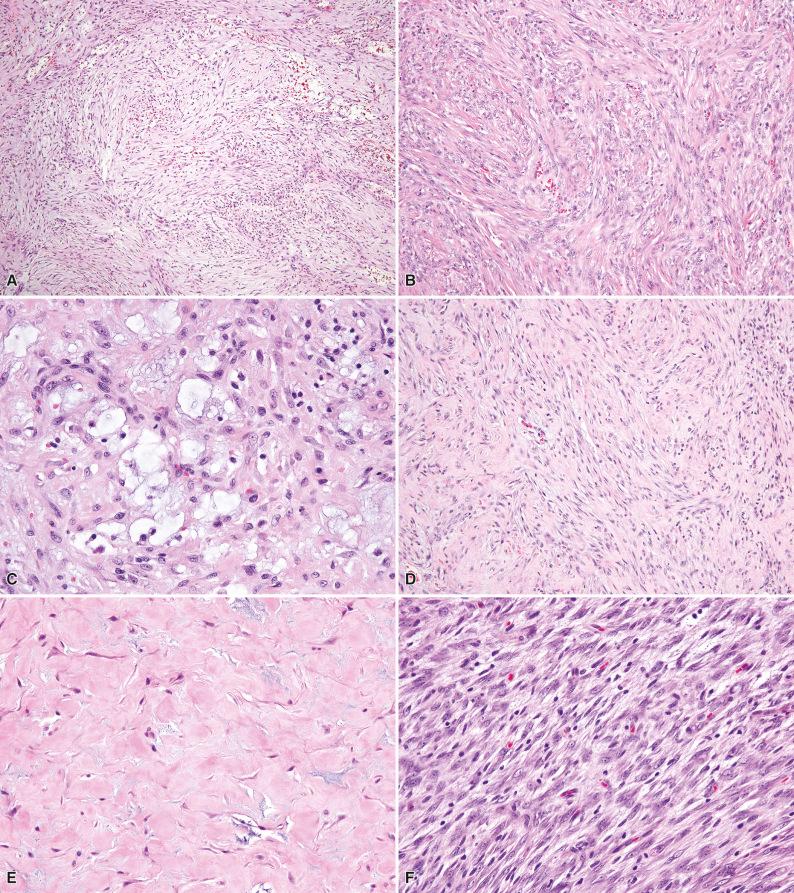
Intramuscular nodular fasciitis is also usually well demarcated. Sometimes, tumor borders are infiltrative, containing some residual entrapped atrophic muscle fibers, akin to desmoid fibromatosis.
Variants of nodular fasciitis and related and similar lesions are as follows:
Nodular fasciitis with infiltrative borders. Some cases have notably infiltrative borders, more closely mimicking sarcoma.
Nodular fasciitis with high cellularity. In this form, there is little or no myxoid background and no zonation phenomenon. The lesion is densely cellular, composed of mitotically active spindle cells arranged in short fascicles (see Fig. 3.4F ). Such tumors can easily be misdiagnosed as spindle cell sarcomas.
Cranial fasciitis. This lesion occurs mostly in male infants during the first year of life, frequently following birth trauma (e.g., delivery by forceps) (see Chapter 4 ). It develops in the soft tissues of the scalp, from the galea aponeurotica, and it may erode and even penetrate the underlying bone with involvement of meninges. It is often visible on plain radiographs as a lytic lesion of the calvarium. Histologically, it resembles conventional nodular fasciitis but may also contain areas of osseous metaplasia.
Intravascular fasciitis. This is a rare variant of nodular fasciitis (3% of cases) that grows into and obstructs medium-size veins or, less often, arteries. It may show a multinodular growth pattern inside the same vessel. Intravascular fasciitis tends to be less myxoid and to contain more osteoclast-like giant cells than common nodular fasciitis. It is most often observed in the subcutaneous tissues of the upper limbs or the head and neck.
Proliferative fasciitis and proliferative myositis, which are morphologically similar lesions. Proliferative fasciitis usually occurs in the subcutaneous tissues of the upper limbs (especially forearms) of middle-aged adults (40 to 60 years of age), whereas proliferative myositis mainly affects the flat muscles of the trunk and shoulder girdle. Histologically, in addition to the other findings of nodular fasciitis, the key feature of these two lesions is the presence of unusual large epithelioid cells that resemble ganglion cells or rhabdomyoblasts ( Fig. 3.5 ), containing abundant amphophilic or basophilic cytoplasm and often eccentric, vesicular nuclei with prominent nucleoli (see Fig. 3.5C ). Binucleated forms may also be seen (see Fig. 3.5D ). The distinctive epithelioid cells tend to form small clusters. In children, proliferative fasciitis may be very cellular and mitotically active, consisting almost exclusively of ganglion-like cells, and thus closely mimic rhabdomyosarcoma. In proliferative myositis, fasciitis-like areas containing ganglion-like cells alternate with foci of atrophic skeletal muscle resulting in a typical “checkerboard” pattern, apparent at low magnification ( Fig. 3.6 ).
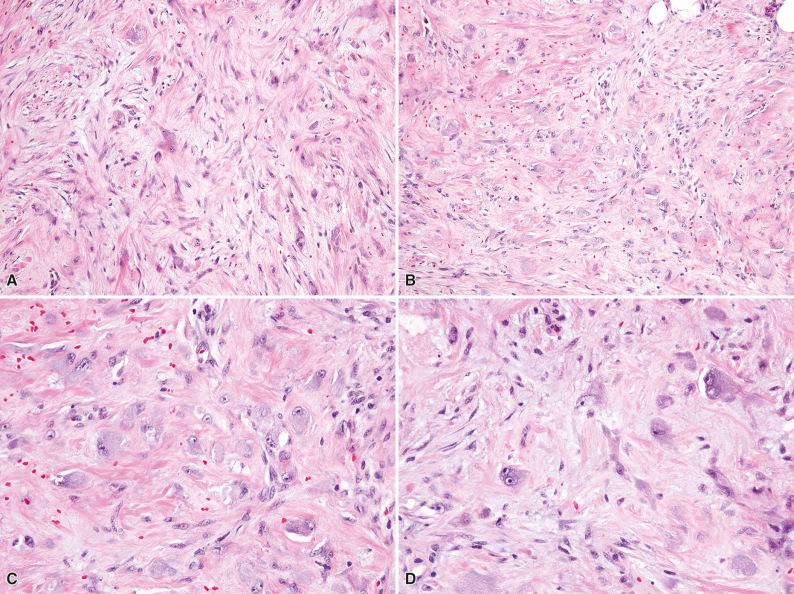

Ischemic fasciitis (also known as “atypical decubital fibroplasia”), which is somewhat similar to proliferative fasciitis because it also contains ganglion-like cells. This lesion usually involves the soft tissues overlying bony prominences, such as the shoulder, the chest wall, and the sacrococcygeal and greater trochanter regions. It occurs over a wide age range, with a peak in elderly adults (70 to 90 years of age); some affected patients are physically debilitated or immobilized. Histologically, ischemic fasciitis characteristically shows a zonal appearance with central areas of fibrinoid necrosis and cystic change, surrounded by granulation tissue and plump amphophilic ganglion-like myofibroblasts ( Fig. 3.7 ).
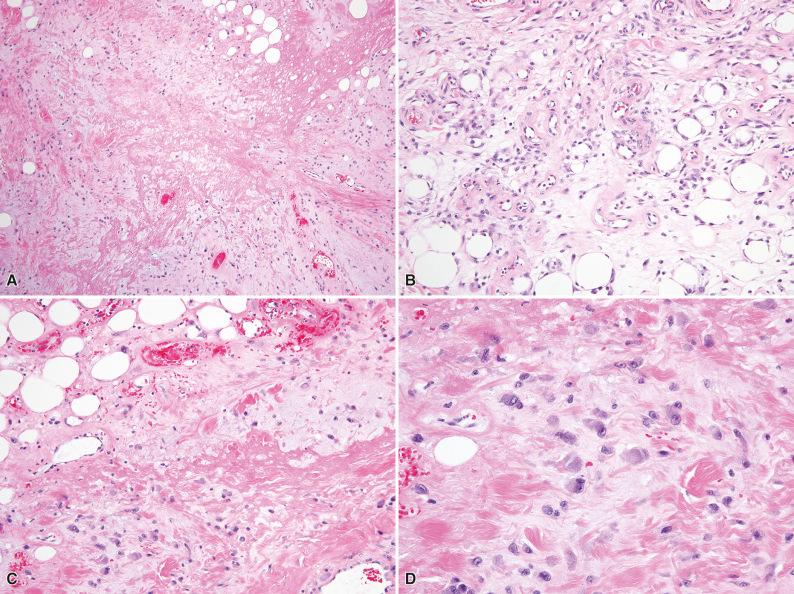
Ossifying fasciitis (also known as fasciitis ossificans) is a variant of fasciitis that contains foci of metaplastic bone, but lacking the typical zonation of myositis ossificans (see Chapter 14 ). When mitotic activity and ossification are prominent, extraskeletal osteosarcoma enters the differential diagnosis.
Fasciitis ossificans, myositis ossificans, panniculitis ossificans, florid reactive periostitis, and fibro-osseous pseudotumor of the digits are related benign ossifying pseudosarcomatous fibroblastic/myofibroblastic proliferations (see Chapter 14 ). Although zonal maturation is typical of myositis ossificans, other lesions in this family lack such architectural organization.
Myofibroblasts in nodular fasciitis are usually strongly, diffusely positive for smooth muscle actin, muscle-specific actin (clone HHF35), and calponin. Desmin reactivity is observed in only few scattered cells. Caldesmon, S-100 protein, CD34, and β-catenin are not expressed. Occasional visceral lesions show reactivity for keratins. Intralesional histiocytes and osteoclast-like giant cells express CD68 and other histiocyte markers. Proliferation markers (Ki-67) stain a large number of nuclei, in keeping with high proliferative activity of these lesions. The ganglion-like cells in proliferative fasciitis and proliferative myositis are often negative for muscle markers.
Despite the clinical features that suggest a reactive lesion, nodular fasciitis is a clonal proliferation, as shown by the clonal chromosomal rearrangements detected in lesions analyzed cytogenetically. Rearrangements of the USP6 locus at 17p13 have been detected in greater than 90% of cases of nodular fasciitis. The MYH9-USP6 gene fusion was detected in 65% of cases, resulting in overexpression of the USP6 oncoprotein by a promoter swap mechanism, similarly to aneurysmal bone cyst (see Chapter 14 ). An alternative PPP6R3-USP6 fusion with amplification has been reported in a single unusual aggressive case ; other gene fusions remain to be identified.
Nodular fasciitis is often mistaken for a sarcoma (20% to 30% of cases), mainly because of its high cellularity, poor circumscription, rapid growth, and brisk mitotic activity ( Box 3.3 ). However, in contrast to most sarcomas, nodular fasciitis grows very rapidly (within a few weeks), is generally small and located in subcutis, does not contain enlarged and/or hyperchromatic nuclei, and does not show tumor necrosis or atypical mitotic figures.
Intramuscular/cellular myxoma
Myxofibrosarcoma
Malignant peripheral nerve sheath tumor
Myxoid dermatofibrosarcoma protuberans
Low-grade fibromyxoid sarcoma
Benign fibrous histiocytoma
Myofibroma
Cellular schwannoma
Desmoid fibromatosis
Leiomyosarcoma
Kaposi sarcoma
Spindle cell carcinoma
Spindle cell melanoma
Fibroma of tendon sheath
Desmoplastic fibroblastoma
Neurofibroma
Perineurioma
Rhabdomyosarcoma
Pleomorphic sarcomas
Ganglioneuroblastoma
Extraskeletal osteosarcoma
Myxofibrosarcoma
Epithelioid sarcoma
Predominantly myxoid examples of nodular fasciitis may be confused with myxofibrosarcoma. As opposed to nodular fasciitis, myxofibrosarcoma occurs in the elderly, tends to be multinodular, often shows alternating cellular and myxoid areas, and, most importantly, contains tumor cells with enlarged hyperchromatic nuclei, which are not a feature of nodular fasciitis. Myxoid forms of nodular fasciitis can also be confused with myxoid DFSP (positive for CD34, negative for smooth muscle actin), myxoid forms of low-grade MPNST (positive for S-100 protein, glial fibrillary acidic protein [GFAP], and/or SOX10 in 40% to 50% of cases), and low-grade fibromyxoid sarcoma (LGFMS) (positive for MUC4 and EMA, negative for smooth muscle actin). Hypercellular forms of nodular fasciitis should be distinguished from leiomyosarcoma (large size, reactivity for desmin and caldesmon, in addition to smooth muscle actin), myofibroblastic sarcoma (expression of smooth muscle actin and desmin, negative for caldesmon), Kaposi sarcoma (expression of CD31, CD34, ERG, and human herpesvirus 8), and spindle cell carcinoma (reactivity for keratins, variable EMA, and p63). Lesions containing a large number of ganglion-like cells or rhabdomyoblast-like cells can mimic embryonal or pleomorphic rhabdomyosarcoma (reactivity for actin, desmin, and myogenin) or other pleomorphic sarcomas, as well as ganglioneuroblastoma. Extraskeletal osteosarcoma is the main differential diagnostic consideration for ossifying fasciitis and related lesions. In contrast to ossifying fasciitis, extraskeletal osteosarcoma usually occurs in patients of advanced age (sometimes following radiation therapy), is composed of atypical tumor cells with hyperchromatic nuclei, may contain areas of tumor necrosis, and tends to show bone maturation in the center of the lesion rather than at its periphery. Osteoid deposition is also usually less organized in osteosarcoma than in ossifying fasciitis. Marked cellular pleomorphism and atypical mitoses are common in osteosarcoma but virtually absent in ossifying fasciitis.
Nodular fasciitis is a benign, self-limiting process. Simple excision is the treatment of choice. Local recurrences are exceptional (<2% of cases). Spontaneous regression may occur.
Presentation is a rapidly growing, usually subcutaneous tumor in young to middle-aged adults
Forearm and head and neck are the most common sites
Rarely arises in the skin, joints, or blood vessels
Initially highly cellular; long-standing lesions become hypocellular and fibrotic
Myxoid stroma, extravasated erythrocytes, and a tissue culture–like appearance are typical
Lesions somewhat similar to nodular fasciitis have been reported at mucosal sites under various designations: visceral fasciitis, pseudosarcomatous fibromyxoid tumor, pseudomalignant spindle cell proliferation, postoperative spindle cell nodule, and inflammatory pseudotumor. They most often arise in the genitourinary tract. These lesions belong to a clinically and histologically distinct group that is now widely referred to using the descriptive designation pseudosarcomatous myofibroblastic proliferation (PMP).
PMP can be observed at any age but predominantly in adults, with no gender predilection. The genitourinary tract is the most common location (urinary bladder, prostate, urethra, vagina, and vulva), but the lesion may occasionally arise at any mucosal site, including the gastrointestinal tract and the head and neck area (larynx, pharynx, nasal cavity, and mouth). In most patients, it arises spontaneously. In a subset of patients the lesion appears following surgery or instrumentation in the same area, in which case the designation postoperative spindle cell nodule has been applied. Such cases, which have been described in the vulva, vagina, urinary bladder, and prostatic urethra, typically occur 1 to 3 months after trauma or an invasive procedure (e.g., transurethral resection of the prostate or urinary bladder, or endometrial curettage). Hemorrhage (e.g., gross hematuria for lesions developing in the urinary tract) is the most common presenting symptom.
Grossly, PMP (including postoperative lesions) usually presents as exophytic or polypoid, frequently ulcerated masses that have a tendency to bleed easily. They generally measure less than 5 cm in maximal diameter, but lesions up to 7 cm have been reported in the urinary bladder.
Histologically, PMP consists of a spindle cell proliferation in which cellular elements are arranged in loose fascicles ( Fig. 3.8 ), although some examples are densely cellular and fascicular. The spindle cells have abundant, elongated, eosinophilic to amphophilic cytoplasm (see Fig. 3.8B ). Strap-shaped cells may be seen in myxoid areas. Tumor cell nuclei are oval- to spindle-shaped with vesicular chromatin and one or two prominent nucleoli. Marked nuclear pleomorphism is absent. Mitotic activity is variable, ranging from low to brisk in some lesions (10 mitoses or more per 10 high-power fields (HPF)). Atypical mitoses and necrosis are usually absent. The spindle cell proliferation may be admixed with a variable number of inflammatory elements, including neutrophils, eosinophils, lymphocytes, and plasma cells. Myxoid and hemorrhagic changes are frequently observed, as well as numerous capillaries, often oriented toward the ulcerated mucosal surface (akin to granulation tissue).
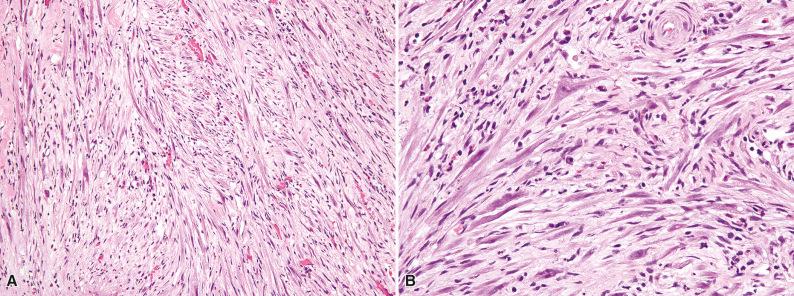
As in nodular fasciitis, spindle cells in PMP usually express muscle-specific actin (HHF35), smooth muscle actin, and focal desmin. One-third of lesions are at least focally positive for keratins. The lesions are consistently negative for S-100 protein and CD34. Approximately 50% of cases of PMP express anaplastic lymphoma kinase (ALK), thus overlapping with inflammatory myofibroblastic tumor and complicating the differential diagnosis.
A large majority of PMPs do not bear specific chromosomal abnormalities, although some inconsistent chromosomal alterations have been reported in several cases. Some authors have reported ALK rearrangements in PMP detected by fluorescence in situ hybridization (FISH). In the authors' experience, despite immunohistochemical expression of ALK, PMPs only rarely show ALK rearrangements. Most myofibroblastic lesions with ALK rearrangements are better classified as inflammatory myofibroblastic tumors (see Chapters 4 and 10 ).
The differential diagnosis of PMP is somewhat similar to that of nodular fasciitis ( Box 3.4 ). Highly cellular examples should be differentiated from leiomyosarcoma, rhabdomyosarcoma, and Kaposi sarcoma. In an appropriate context, spindle cell carcinoma and spindle cell melanoma should also be excluded, especially in patients with a previous history of carcinoma or melanoma.
Making the distinction between PMP and inflammatory myofibroblastic tumor can be difficult, especially for lesions arising in the head and neck region (larynx, mouth) and the genitourinary tract. In the urinary bladder, where PMP predominates, lesions have been reported under various different names (inflammatory pseudotumor, pseudosarcomatous fibromyxoid tumor, inflammatory myofibroblastic tumor, and PMP), illustrating the difficulties encountered in classifying these lesions and, more importantly, in assessing their biologic potential. Some of these tumors bear alterations of the ALK gene on 2p23, express ALK by immunohistochemistry, and may recur locally, whereas others do not. In contrast to inflammatory myofibroblastic tumors, PMPs are usually less cellular and less uniformly fascicular, with more prominent myxoid stroma and a sparse inflammatory infiltrate. However, due to the morphologic overlap, a pragmatic approach would be to classify lesions bearing ALK gene alterations as inflammatory myofibroblastic tumors and “ ALK –wild type” lesions as PMPs. The lack of significant nuclear atypia and hyperchromasia distinguishes PMP from leiomyosarcoma and spindle cell (sarcomatoid) carcinoma. Because the immunophenotypic overlap between PMP and leiomyosarcoma is substantial (including keratin expression), cytologic atypia is the most helpful discriminating feature. If a sarcomatoid carcinoma is considered, expression of p63 or high-molecular-weight keratins would favor a carcinoma, whereas desmin expression would support PMP.
PMP usually does not recur after complete excision. However, occasional repeated local recurrences have been reported. Recurring lesions are morphologically similar to nonrecurring cases, and ALK expression does not correlate with recurrence. Worrisome features such as brisk mitotic activity, tumor necrosis, or infiltration of adjacent structures do not correlate with more aggressive behavior either.
Mycobacterial spindle cell pseudotumors are rare lesions described initially in patients with acquired immunodeficiency syndrome (AIDS), which can also occur in other immunocompromised patients. Few cases have been observed in infants after receiving bacille Calmette-Guérin (BCG) vaccination. These pseudotumors mainly occur in lymph nodes and skin but may affect almost any anatomic site (lungs, brain, spleen, nasal cavity). They are composed of a heterogeneous population of fibroblasts, myofibroblasts, and epithelioid to spindled histiocytes, which are laden with numerous acid-fast bacilli ( Fig. 3.9 ). In most instances the organisms represent atypical mycobacteria, especially Mycobacterium avium-intracellulare . Histoid leprosy, a rare form of lepromatous leprosy, may also display the appearances of a spindle cell tumor, mimicking benign fibrous histiocytoma of the skin.
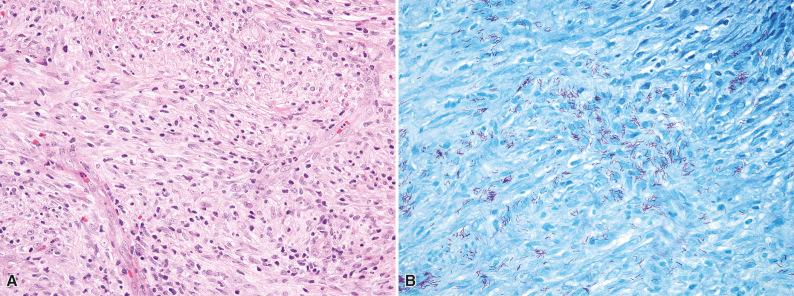
Myofibroma is a benign neoplasm of superficial soft tissues showing perivascular myoid differentiation. In the context of infantile myofibromatosis (discussed in detail in Chapter 4 ), solitary or multiple myofibromas present within the first decade of life, usually before 2 years of age. Morphologically identical lesions in adults are more often solitary, although rare examples of multicentric disease have also been described. Myofibroma and myofibromatosis lie on a histologic continuum with the other tumor types that show perivascular myoid differentiation, that is, myopericytoma and glomangiopericytoma, the distinction between them sometimes being arbitrary due to considerable morphologic overlap. The designation perivascular myoma has been proposed to designate these three lesions collectively.
Adult myofibroma is a solitary painless cutaneous, subcutaneous, or mucosal nodule, most commonly located in the head and neck region or in the lower extremity in adults of any age. Multicentric cases, generally affecting the same anatomic region, are much less frequent in adults than in infants. Cases involving deep-seated locations, including viscera or bone, are extremely rare in adults. Myopericytoma shows a male predominance and also occurs over a wide age range, with a peak in middle-aged adults. Most tumors arise on the extremities, especially the lower limb, and are situated in the subcutaneous tissue or skin.
Histologically, myofibroma in adults is similar to infantile myofibromatosis. The tumors are well circumscribed but unencapsulated, multinodular, biphasic lesions. They consist of two cellular components ( Fig. 3.10 ): (1) a primitive cellular proliferation of small, ovoid to short spindle cells with scant cytoplasm associated with numerous thin-walled branching blood vessels (see Fig. 3.10B ) and (2) whorled nodules and fascicles of plump spindle cells with tapering nuclei and pale eosinophilic cytoplasm. The two components are present in variable proportions, sometimes haphazardly arranged but more often showing a zonal distribution with the primitive component in the center, surrounded by the myoid whorls. “Reverse zonation” is also possible, with the myoid nodules in the center. The primitive cellular areas are usually less conspicuous than in infantile cases, and some myofibromas are composed nearly exclusively of whorled nodules. The myoid nodules may show a basophilic pseudochondroid appearance (see Fig. 3.10C ), as well as prominent stromal hyalinization (see Fig. 3.10D ) and calcification, occasionally dominating the lesion and complicating the diagnosis. Similarly, high cellularity and an infiltrative growth pattern are observed in rare cases and should not be overinterpreted as indicators of aggressive behavior. The cytomorphology is consistently bland, and mitotic figures are rare. Tumor nodules typically bulge into thin-walled veins in a subendothelial fashion ( Fig. 3.11 ), often most easily appreciated at the periphery of the lesion; this finding is of no clinical significance.
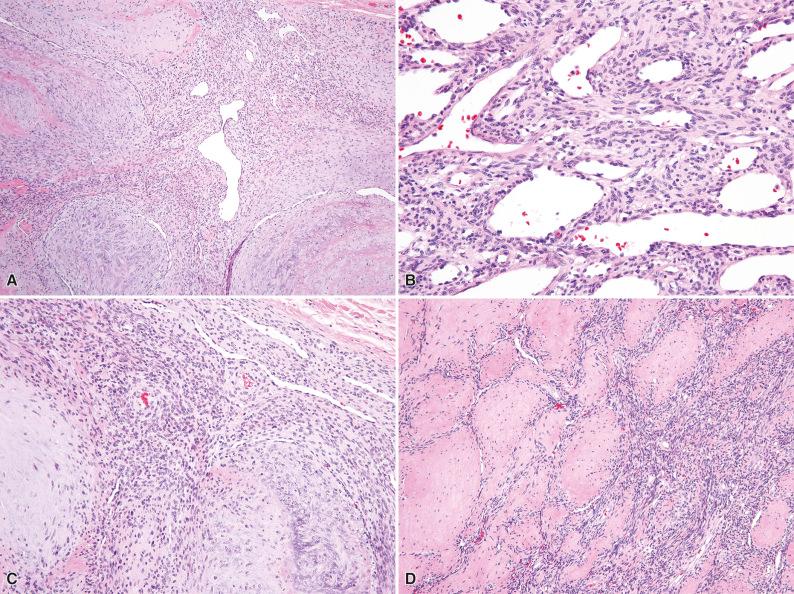
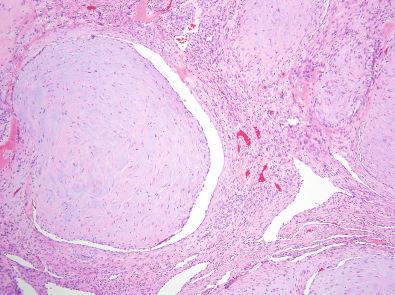
Myopericytoma is composed of ovoid or plump spindle cells with eosinophilic cytoplasm arranged around numerous thin- and thick-walled blood vessels in a concentric fashion ( Fig. 3.12 ). A typical feature is the presence of more subtle perivascular cells within the walls of smaller blood vessels beyond the periphery of the main tumor. Occasional examples show areas composed of rounded tumor cells with more sharply defined cell borders (similar to glomus tumor/glomangiopericytoma). Other cases contain perivascular cells that resemble smooth muscle cells (indistinguishable from angioleiomyoma), whereas some tumors contain myoid nodules similar to those of myofibroma. The spectrum of histologic features that may be observed within individual tumors suggests that myofibroma and myopericytoma (and even glomus tumor [see Chapter 6 ] and angioleiomyoma) lie on a continuum. In terms of nomenclature, tumors that are difficult to separate into one category due to overlapping histology may be designated myopericytoma/myofibroma .
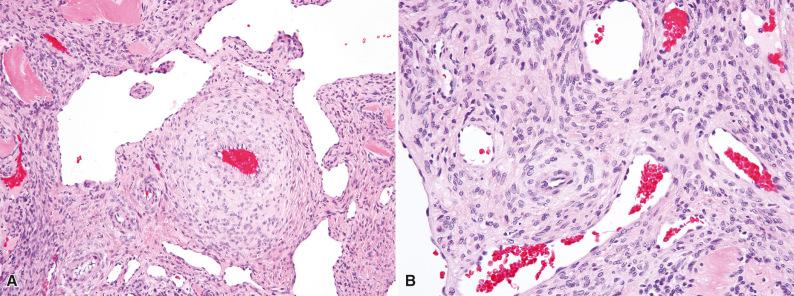
Very rarely, myopericytomas show features of malignancy, in the form of marked nuclear atypia and a high mitotic rate. Such tumors may pursue an aggressive clinical course.
The tumor cells in both myofibroma and myopericytoma are extensively positive for smooth muscle actin and often for h-caldesmon, whereas desmin is focally positive in only a small subset of cases. The primitive, cellular component in myofibroma typically shows less smooth muscle actin expression than the myoid nodules. Tumor cells are negative for S-100 protein, EMA, keratins, and CD34, although CD34 highlights the prominent vascular component.
Myofibromas are characterized by activating PDGFRB mutations. Germline heterozygous p.R561C and p.P660T PDGFRB mutations were first identified in familial infantile myofibromatosis. Subsequently, approximately 70% of sporadic solitary myofibromas were found to harbor gain-of-function mutations in exons 12 and 14 of PDGFRB ; almost every sporadic case in that study had a combination of two heterozygous PDGFRB mutations, an intriguing finding that, if validated, would suggest that transformation in myofibroma requires gain-of-function mutation of both PDGFRB alleles or, alternatively, that two mutations in cis are required to fully activate PDGFRB in this context. Mutations in other genes such as NOTCH3 have been described, indicating some degree of genetic heterogeneity. A small group of malignant myopericytomas and spindle cell sarcomas with features resembling myofibromatosis show NTRK1 gene fusions.
The differential diagnosis of myofibroma includes nodular fasciitis, fibroma of tendon sheath, leiomyoma, dermatomyofibroma, and, as described previously, other perivascular myoid lesions, myopericytoma, and glomangiopericytoma (see Chapter 6 ). Nodular fasciitis typically contains looser fascicles than myofibroma with variably prominent myxoid stroma and extravasated erythrocytes, and it lacks the biphasic pattern and the prominent thin-walled branching vessels of myofibroma. Fibroma of tendon sheath also lacks the biphasic architecture of myofibroma and usually contains more collagenous stroma with slitlike blood vessels at the tumor periphery. Leiomyoma shows a more homogeneously fascicular growth pattern, with longer spindle cells with brightly eosinophilic cytoplasm. Although both leiomyoma and myofibroma are positive for smooth muscle actin, only leiomyomas show diffuse and strong desmin expression. Dermatomyofibroma (see Chapter 15 ), which is a plaquelike dermal proliferation of fibroblasts and myofibroblasts arranged parallel to the epidermis, lacks the nodular growth pattern and the biphasic appearance of myofibroma. Other perivascular myoid lesions usually lack the classic biphasic appearance and myoid nodules of myofibroma: in myopericytoma, the short spindle cells are concentrically arranged around vascular lumina in an “onionskin” (multilayered) pattern, whereas glomangiopericytoma tends to have larger, more dilated vessels surrounded by rounded cells with sharp cell borders; however, the morphologic overlap among these lesions is significant and the distinction can sometimes be purely semantic.
Adult myofibroma and myopericytoma are benign tumors that rarely recur following marginal or even intralesional excision. Recurrences likely represent continued growth after incomplete excision. Simple surgical excision is adequate treatment. Occasionally, patients develop additional lesions, usually in the same anatomic region. Rare aggressive tumors or extensive lesions not amenable to surgical resection harboring PDGFRB mutations or NTRK1 fusions may benefit from treatment with imatinib, nilotinib, or similar tyrosine kinase inhibitors.
Myofibroma and myopericytoma lie on a histologic continuum
Presentation is a painless subcutaneous nodule, in adults most often solitary but occasionally multiple
Myofibroma is typically biphasic with small ovoid cells with scant cytoplasm associated with numerous thin-walled blood vessels and whorled nodules of plump myoid spindle cells
Myoid nodules often show a pseudochondroid appearance
Myoid nodules typically bulge into the lumina of veins
Myopericytoma is composed of spindle cells with eosinophilic cytoplasm arranged around thin- and thick-walled blood vessels
Phosphaturic mesenchymal tumor (PMT), also referred to as “PMT, mixed connective tissue variant,” is a rare distinctive mesenchymal neoplasm that may arise in both soft tissue and bone and is characterized by somewhat heterogeneous but recognizable histologic appearances. It frequently elicits a clinical paraneoplastic syndrome consisting of hypophosphatemic (hyperphosphaturic) osteomalacia.
PMT usually affects middle-aged adults with an equal gender distribution. The tumor arises at a wide range of anatomic locations with a predilection for the extremities (especially the thigh and foot). Similar numbers of cases arise primarily in soft tissue (either superficial or deep) and bone. The symptomatology is usually related to long-standing, vitamin D–resistant, severe osteomalacia, leading to stress fractures and pain. Laboratory testing reveals hypophosphatemia and hyperphosphaturia, normocalcemia, and increased serum alkaline phosphatase. Rarely, morphologically identical lesions occur without the clinical syndrome or identifiable laboratory abnormalities. Radiologic features are not distinctive.
Histologically, PMT has a range of appearances, being composed of variable proportions of bland spindled-to-stellate cells, adipocytes, and osteoclast-type giant cells embedded in an abundant extracellular chondromyxoid to hyalinized matrix with irregular, coarsely granular, or flocculent calcifications ( Fig. 3.13 ). The tumors usually contain a prominent vasculature, consisting of small capillaries and medium-sized blood vessels, some with an ectatic, branching, HPC-like appearance. In some cases the tumor cells focally have a more myoid or glomoid appearance and are situated around blood vessel walls (see Fig. 3.13B ). Perivascular hyalinization, osteoid deposition, and microcystic or hemorrhagic changes are common. A rim of ossification may be present at the periphery of the lesion. The tumor cellularity is usually low, and the cytomorphology is bland, with fine chromatin and small nucleoli, and mitotic activity is scant or absent. Very rare cases show increased cellularity, larger nuclear size and pleomorphism, and a mitotic rate greater than 5 per 10 HPF, which may be associated with malignant behavior.
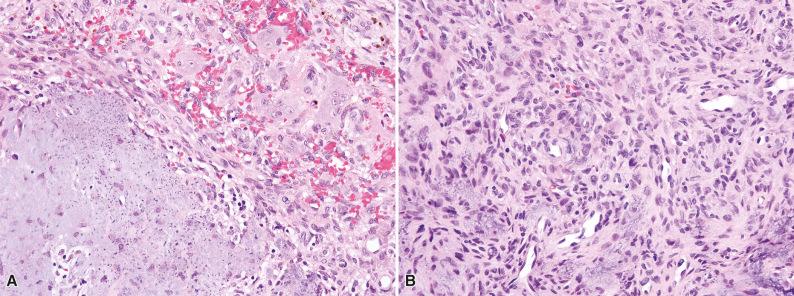
Tumors occurring in bone usually have similar histologic features as the cases affecting soft tissues but may sometimes resemble other bone tumors. These conditions have accordingly been designated osteoblastoma-like , nonossifying fibroma–like , and ossifying fibroma–like variants of PMT.
Conventional immunohistochemical markers are not useful in the diagnosis of PMT. A minority of tumors shows focal expression of smooth muscle actin. Tumor cells are negative for CD34, desmin, S-100 protein, and keratins. Approximately 80% of PMT express FGFR1, but expression in some morphologic mimics (such as 40% of SFT) reduces the diagnostic value of this marker. Immunohistochemical detection of fibroblast growth factor 23 (FGF23) has been used in research settings; the majority of cases tested have been positive.
Two recurrent gene fusions have been detected in PMT: FN1-FGFR1 and FN1-FGF1 , in 40% and 5% of cases, respectively. The structure of both fusion proteins suggests an autocrine/paracrine mechanism of activation of the FGFR1 signaling pathway, both by FGF1 and other ligands such as FGF23. Secretion of FGF23 by tumor cells is believed to be responsible for the oncogenic osteomalacia that affects patients with PMT, by inhibiting renal tubular phosphate transport. More than 90% of cases of PMT with oncogenic osteomalacia express FGF23, as well as 75% of histologically identical tumors that present without the clinical paraneoplastic syndrome. Although identifying FGF23 expression by tumor cells may be useful to confirm the diagnosis of PMT and may provide insights into the mechanisms leading to hyperphosphaturia in some cases, its diagnostic value is limited due to the existence of cases of PMT lacking FGF23 expression (likely expressing alternative phosphaturic factors), and, more importantly, the expression of FGF23 by other mesenchymal tumors that do not induce osteomalacia. Detection of a FGFR1 or FGF1 rearrangement by FISH will provide strong confirmatory evidence in the appropriate context, albeit with low sensitivity.
The integration of clinical information and morphologic features allows for the diagnosis of PMT; however, without the suggestive clinical context, the differential diagnosis may be broad given the relative polymorphism of these lesions, including morphologic findings that may be misinterpreted as reactive changes. The vascular pattern in PMT may suggest SFT, which is usually a more cellular lesion that contains more prominent thicker-walled branching blood vessels, lacks the calcified chondromyxoid matrix of PMT, and is usually diffusely positive for CD34 and STAT6. On the other hand, soft tissue chondroma may show a similar calcification pattern and may contain osteoclast-like giant cells; however, it lacks the bland spindled-to-stellate cells and the adipocytic component typical of PMT. Cases with prominent myoid cells may be confused with myofibroma, but the latter tumor type lacks the flocculent calcification and osteoclast-like giant cells of PMT.
Most PMT are clinically benign, although occasional cases recur locally. Complete resection of the tumor results in recovery of osteomalacia, as well as remission of the clinical symptoms and laboratory abnormalities. Exceptional malignant examples can usually be recognized on morphologic grounds (based on increased cellularity, marked nuclear atypia, and high mitotic activity). Malignant PMT has a significant potential for local recurrence and may also metastasize. The efficacy of FGFR inhibitors to treat PMT and tumor-induced osteomalacia is being tested in clinical trials.
Primary soft tissue tumors indistinguishable from myofibroblastoma of the breast are designated mammary-type or extramammary myofibroblastoma (see Chapter 17 ). Similar to its breast counterparts, mammary-type myofibroblastoma is a benign neoplasm related to spindle cell lipoma, which most frequently affects older male patients and arises in subcutaneous tissue. The anatomic distribution is wide, with approximately 40% of cases located in the groin or inguinal region and 5% to 10% of cases in the trunk or lower extremities; rare cases are deep seated, in intracavitary or visceral locations. The tumor is well circumscribed but unencapsulated and consists of a haphazard arrangement of variably sized fascicles of spindled to ovoid cell, embedded in a collagenous stroma with interspersed thick hyalinized collagen bundles ( Fig. 3.14 ). The cytomorphology is similar to that of spindle cell lipoma, with spindle cells containing short stubby nuclei and ill-defined, scant palely eosinophilic to amphophilic cytoplasm (see Fig. 3.14B ). Focal cytologic atypia or occasional multinucleated cells may be seen. An adipocytic component is often present, sometimes predominating, which can show variability in adipocyte size but lacks atypical adipocytes or true lipoblasts. Stromal mast cells can be prominent. Mitoses may be easily identified (sometimes more than 5 per 10 HPF), but atypical mitotic figures are absent. By immunohistochemistry, the lesional cells are usually positive for both desmin and CD34, whereas RB1 expression is lost in approximately 90% of cases. Expression of smooth muscle actin and S-100 is uncommon. The molecular genetic features of mammary-type myofibroblastoma are identical to those of spindle cell lipoma and consist of monoallelic or biallelic deletions of chromosome 13q (in particular 13q14), sometimes in combination with monosomy 16q.
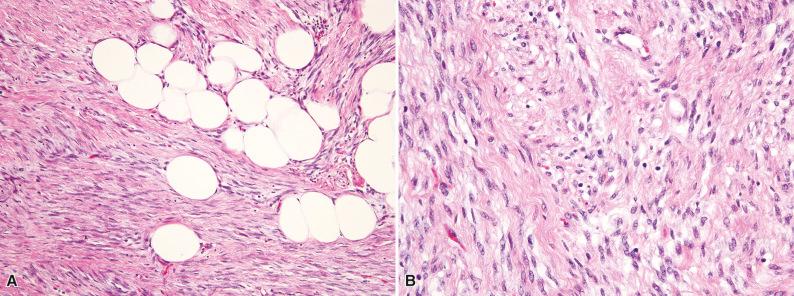
The differential diagnosis of mammary-type myofibroblastoma of soft tissue is wide and, depending on the anatomic location, may include benign lesions such as spindle cell lipoma, cellular angiofibroma, angiomyofibroblastoma, soft tissue perineurioma, and SFT, and intermediate and malignant tumors such as DFSP, atypical spindle cell lipomatous tumor, and low-grade MPNST. Spindle cell lipoma shows significant morphologic overlap with mammary-type myofibroblastoma, although subtle differences exist. Mammary-type myofibroblastoma usually contains a less prominent adipocytic component than spindle cell lipoma and shows a more fascicular architecture; the background collagenous stroma is generally more prominent, with thick collagen bundles, sometimes arranged in a zigzag pattern. In contrast to spindle cell lipoma, mammary-type myofibroblastoma is typically positive for desmin in addition to CD34. Cellular angiofibroma contains hyalinized blood vessels, which are not a feature of mammary-type myofibroblastoma. In addition, although CD34 may be positive, desmin and smooth muscle actin are usually negative. Angiomyofibroblastoma mainly affects female patients and is characterized by prominent small vessels and a population of rounded, usually perivascular cells that are typically desmin positive. Particularly in postmenopausal women, angiomyofibroblastoma may have a more hyalinized stroma and a more spindled appearance and thus more closely resemble mammary-type myofibroblastoma. Desmin is often negative in such cases (see Chapter 17 ). Soft tissue perineurioma is composed of slender spindle cells with long bipolar cytoplasmic processes that are usually arranged in a storiform to whorled (rather than fascicular) pattern and express EMA but are negative for desmin. SFT may also enter the differential diagnosis of mammary-type myofibroblastoma in that it is a well-circumscribed, CD34-positive spindle cell lesion with a ubiquitous anatomic distribution, sometimes containing adipocytes (fat-forming SFT). SFT has a patternless appearance, lacking the fascicular architecture of mammary-type myofibroblastoma, and contains prominent HPC-like branching, dilated vessels. Desmin positivity is rare in SFT and usually very focal when present; STAT6 is specific for SFT in this differential diagnosis.
DFSP potentially may also enter into the differential diagnosis if a small biopsy showing tumor infiltration into fat is examined. DFSP arises in the dermis, rather than deeper soft tissues, is usually markedly hypercellular with a tight storiform architecture, and shows diffuse infiltration of adipose tissue. Although the tumor cells are positive for CD34, they are negative for desmin. Atypical spindle cell lipomatous tumor is generally larger, with more stromal and adipocytic nuclear atypia including scattered hyperchromatic cells and variation in adipocyte size. Lipoblasts can generally be found. The spindle cells of low-grade MPNST typically contain more tapering or buckled nuclei with cytologic atypia and often show perivascular accentuation. Tumor cells are usually negative for desmin, whereas 40% to 50% of MPNSTs are positive for S-100 protein or SOX10 (although the expression is typically only focal in distribution).
Mammary-type myofibroblastoma is a benign lesion, with no potential to recur or metastasize. Simple surgical excision is adequate treatment.
So-called palisaded myofibroblastoma is a benign intranodal myofibroblastic proliferation with a predilection for the inguinal lymph nodes. It has also been referred to as intranodal hemorrhagic spindle cell tumor with amianthoid fibers , reflecting two prominent histologic features: the deposition of abundant extracellular collagen bundles, resulting in stellate crystalline structures, and frequent interstitial hemorrhage. The tumors affect middle-aged adults as a painless mass, males being affected twice as frequently as females. Most cases have been described in the inguinal lymph nodes, some also in a submandibular location.
The lesion usually occupies the center of the lymph node, with scattered hemorrhagic areas ( Fig. 3.15 ). Histologically, the most distinctive feature is the presence of abundant deposits of eosinophilic fibrillary material (amianthoid fibers) ( Fig. 3.16 ), composed of collagens type I and III. The fascicles of spindle cells are interspersed within these structures, often with a radial arrangement showing prominent nuclear palisading (see Fig. 3.16 ). The cells show bland myofibroblastic morphology, with small ovoid nuclei and scant palely eosinophilic cytoplasm. Paranuclear eosinophilic globules may be present. Interstitial hemorrhage with hemosiderin deposition is often prominent. Focal myxoid stroma may be present, resulting in areas reminiscent of nodular fasciitis. Metaplastic bone formation has been described. Hotspot mutations in CTNNB1 have been identified in intranodal myofibroblastoma, leading to nuclear expression of β-catenin and cyclin D1. The tumor cells also express smooth muscle actin but only occasionally desmin, and they are negative for CD34 and S-100.

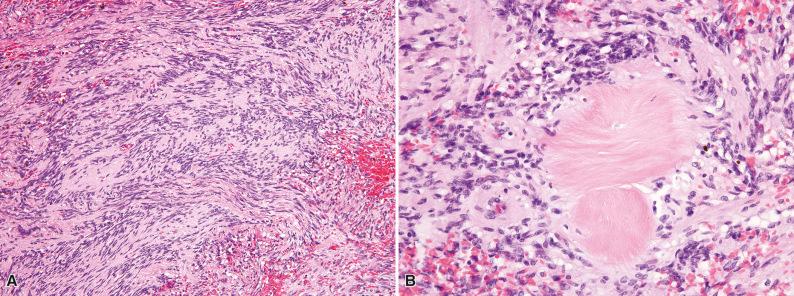
The diagnosis of intranodal myofibroblastoma is usually straightforward due to the presence of amianthoid fiber–like extracellular material. However, in some cases, schwannoma, dendritic cell sarcomas, and Kaposi sarcoma may conceivably enter the differential diagnosis. Schwannoma typically shows alternating cellular (Antoni A) and hypocellular areas with hyalinization of vessel walls, in addition to diffuse, strong expression of S-100 protein. Dendritic cell sarcomas often show a syncytial growth pattern with prominent intratumoral lymphocytes and at least mild nuclear atypia. Follicular dendritic cell sarcomas are positive for CD21 and CD35, whereas interdigitating dendritic cell sarcomas express S-100 protein. Kaposi sarcoma often shows a fascicular architecture with prominent slitlike spaces and hemorrhage. The clinical context should help in the diagnosis of Kaposi sarcoma (see Chapter 13 ), in addition to expression of CD34 and human herpesvirus 8, which are absent in intranodal myofibroblastoma.
Intranodal myofibroblastoma is a benign lesion, for which simple surgical excision is adequate treatment. Exceptional cases of recurrence and multifocality have been reported. The tumor has no potential to metastasize.
The term fibroma has been applied to variety of lesions composed of spindle cells set in an abundant collagenous stroma. Many different types of fibroma have been described based on location (e.g., fibroma of tendon sheath, nasopharyngeal fibroma [angiofibroma], nuchal-type fibroma), composition (e.g., sclerotic fibroma [storiform collagenoma] of the skin, desmoplastic fibroblastoma, elastofibroma), or association with specific syndromes (Gardner fibroma). Of note, the nonspecific designation “fibroma” should be avoided because this term does not refer to a specific soft tissue tumor type. The cutaneous lesions (storiform collagenoma/sclerotic fibroma, pleomorphic fibroma) are discussed in Chapter 15 . Nasopharyngeal angiofibroma and Gardner fibroma are discussed in Chapter 4 .
Fibroma of tendon sheath is a rare tumor that most often arises in the hands of adults between 20 and 50 years of age, with a 2 : 1 male predominance. It usually occurs as a well-circumscribed, slowly growing, painless nodule attached to tendons. The thumb, index finger, middle finger, and wrist are predominantly affected (80% of cases). Less frequently, it may develop on the sole of the foot or close to the knee. Pain or trigger finger are occasional presenting symptoms.
Despite similarities in clinical presentation and gross appearance, there is no good evidence that fibroma of tendon sheath and localized tenosynovial giant cell tumor (giant cell tumor of tendon sheath) are related.
Fibroma of tendon sheath is usually small (0.5 to 2 cm) and firm. Cut section reveals a glistening, gray-white, sometimes multilobulated lesion.
Histologically, fibroma of tendon sheath is a well-delineated hypocellular collagenous lobulated nodule containing spindled to stellate fibroblasts; thin-walled, curvilinear blood vessels; and stromal pseudovascular spaces ( Fig. 3.17 ). Some fibromas of tendon sheath may contain hypercellular areas composed of tightly apposed, bland-appearing fibroblasts, resembling nodular fasciitis ( Fig. 3.18 ). Multinucleated osteoclast-like giant cells are usually absent. Myxoid change, cyst formation, or areas of osseous or cartilaginous metaplasia may occasionally be seen. Rare examples of fibroma of tendon sheath contain few pleomorphic cells (showing degenerative nuclear atypia).

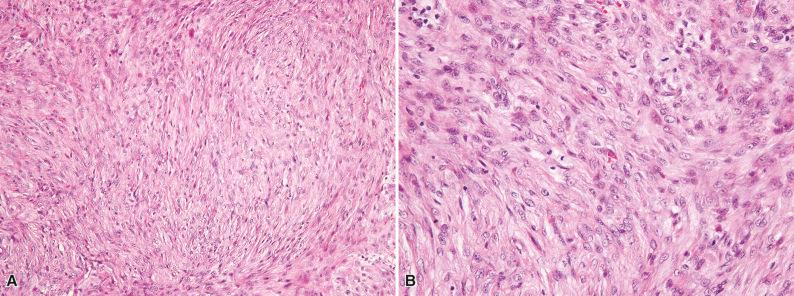
The tumor cells often express smooth muscle actin but are negative for desmin, CD34, keratins, EMA, and S-100 protein.
A translocation t(2;11)(q31;q12) has been reported in fibroma of tendon sheath. Interestingly, similar chromosomal abnormalities involving the region 11q12 have been observed in desmoplastic fibroblastoma (collagenous fibroma), suggesting a potential relationship between these two entities.
The differential diagnosis of fibroma of tendon sheath primarily includes nodular fasciitis and superficial fibromatoses, although fibrous histiocytoma, giant cell tumor of tendon sheath, and soft tissue chondroma (if cartilaginous metaplasia is present) may also be considered. Nodular fasciitis rarely arises on the hands and fingers. In contrast to fibroma of tendon sheath, nodular fasciitis is composed of loose fascicles of plump spindle cells with a “tissue culture”-like appearance including microcysts and extravasated erythrocytes, and it typically lacks prominent stromal collagen and peripheral slitlike blood vessels. Palmar fibromatosis shows a more nodular, infiltrative growth pattern. Fibrous histiocytoma involves the skin and is composed of a more heterogeneous cellular population with short spindle cells, lymphocytes, and foamy macrophages, and it shows peripheral collagen entrapment. Giant cell tumor of tendon sheath is dominated by small mononuclear histiocytoid cells, instead of spindle cells. Soft tissue chondroma is a uniformly cartilaginous lesion with a multinodular growth pattern.
Fibroma of tendon sheath may recur locally after simple excision (up to 20% to 25% of cases) but does not metastasize. Reexcision is usually curative.
Described by Evans in 1995 desmoplastic fibroblastoma is an uncommon benign soft tissue tumor. The term collagenous fibroma, which emphasizes its hypocellular appearance and the presence of marked stromal collagenization, is an alternative designation.
Desmoplastic fibroblastoma usually arises in deep subcutaneous tissue or less often in skeletal muscle (25% of cases) of middle-aged adults, with a male predominance (male-to-female ratio, 3 : 1). Most patients experience gradual development of a slow growing, painless mass, measuring 3 to 4 cm on average. The lesion can occur at nearly any anatomic site, although the upper extremities (shoulder, upper arm, forearm) are predominantly affected.
Grossly, desmoplastic fibroblastoma is a well-delineated, firm, ovoid mass with a gray, sometimes glistening cut surface. Histologically, it is relatively well circumscribed but unencapsulated ( Fig. 3.19 ), with a paucicellular, variably collagenous, sometimes multinodular appearance ( Fig. 3.20 ). Peripheral entrapment of adipose tissue or skeletal muscle is common (see Fig. 3.20A ). The key diagnostic feature is the presence of characteristic, widely spaced, spindle-shaped to stellate fibroblasts within edematous to fibromyxoid stroma (see Fig. 3.20B ). Tumor cell nuclei are bland with open chromatin and small central nucleoli. Cytologic atypia and tumor necrosis are absent; mitoses are very rare. Intratumoral vessels are scarce.
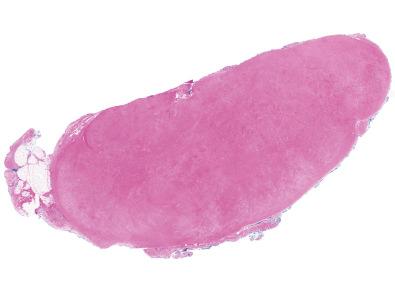
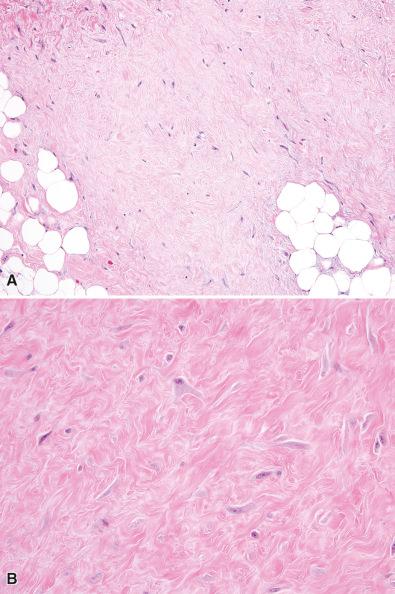
The tumor cells may focally express muscle-specific actin (clone HHF35) and smooth muscle actin. They are negative for desmin, CD34, and S-100 protein. Immunohistochemical detection of FOSL1 expression has been used in research settings but has not been yet validated for clinical purposes.
Alterations of the 11q12 region, including translocation t(2;11)(q31;q12) similar to that observed in fibroma of tendon sheath, have been reported in several desmoplastic fibroblastomas. FOSL1 has been proposed as the target gene of the 11q12 rearrangements in desmoplastic fibroblastoma.
The differential diagnosis of desmoplastic fibroblastoma includes nodular fasciitis, fibroma of tendon sheath (if the lesion is in close proximity to tendons), and desmoid fibromatosis. Nodular fasciitis is generally a more cellular lesion with a more fascicular architecture and microcystic degeneration, and it lacks the typical stellate fibroblasts. Fibroma of tendon sheath is also more cellular and fascicular with prominent stromal collagen and peripheral slitlike blood vessels. Desmoid fibromatosis is composed of long, sweeping fascicles of more elongated spindle cells with medium-sized blood vessels between fascicles. Nuclear staining for β-catenin supports the diagnosis of desmoid fibromatosis.
Simple excision is curative. Desmoplastic fibroblastoma shows no tendency for local recurrence.
Nuchal-type fibroma is an unusual collagenous lesion that may easily be confused with a nonspecific fibrosing process. This lesion shows histologic overlap with Gardner fibroma (see Chapter 4 ).
Nuchal-type fibroma presents as a subcutaneous mass that is localized most frequently, but not exclusively, in the posterior neck region of middle-aged adults (30 to 50 years of age). It has a predilection for men. Rare cases have been observed in the face, upper back, or lumbar region. Approximately 40% to 50% of patients with nuchal-type fibroma have diabetes mellitus. Unlike Gardner fibroma, nuchal-type fibroma is not associated with familial adenomatous polyposis or desmoid tumors.
Grossly, nuchal-type fibroma generally measures between 2 and 8 cm in maximal diameter (median, 3 to 4 cm) and presents as an ill-defined fibrous mass with a gray to white cut surface.
Histologically, nuchal-type fibroma is paucicellular, composed of an admixture of thick bundles of hyalinized collagen, few bland spindled fibroblasts, and entrapped islands of subcutaneous fatty tissue ( Fig. 3.21 ). A cracking artifact between collagen bundles is common (see Fig. 3.21B ). Inflammation is minimal, although stromal mast cells may be observed. The lesion also contains a variable number of elastic fibers (similar to elastofibroma), as well as small blood vessels and small nerves (sometimes resembling traumatic neuroma) ( Fig. 3.22 ). Nuchal-type fibroma may extend into underlying skeletal muscle.
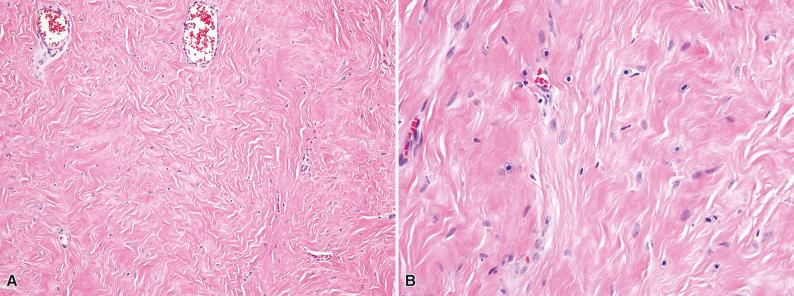
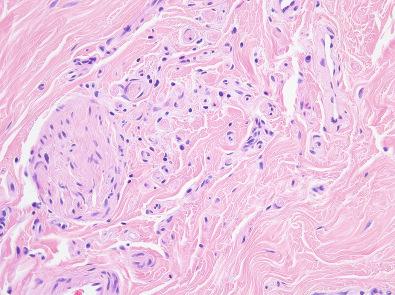
The lesional fibroblasts usually express CD34 (70% to 80% of cases) and are negative for smooth muscle actin, desmin, S-100 protein, and β-catenin.
The main differential diagnosis of nuchal-type fibroma is Gardner fibroma (see Chapter 4 ). The two lesions are nearly indistinguishable morphologically, although the bundles of small nerves typically observed in nuchal-type fibroma are lacking in Gardner fibroma. In contrast to nuchal-type fibroma, Gardner fibroma occurs in infants, children, and adolescents; has no gender predilection; and has no association with diabetes mellitus. Gardner fibroma is highly associated with familial adenomatous polyposis, desmoid fibromatosis, and germline mutations of APC (at least 50% to 70% of cases). Fibroblasts in both tumor types are positive for CD34, but only Gardner fibroma shows nuclear staining for β-catenin. Any lesion with nuchal-type fibroma morphology that occurs in children should be considered a Gardner fibroma, requiring additional clinical (and familial) investigation.
Nuchal-type fibroma is benign. Nondestructive local recurrence may occur, but reexcision is usually curative.
Typical presentation is on the posterior neck of middle-aged adult men
Paucicellular lesion with thick hyalinized collagen bundles and few bland spindle cells
Cracking artifact between collagen bundles is typical
Entrapped small nerves are often seen
Essentially indistinguishable from Gardner fibroma
Elastofibroma is an uncommon lesion that develops in the soft tissues between the lower scapula and chest wall of elderly patients (60 to 80 years of age), with a female predominance. The lesion can be bilateral (10% of cases) and may occasionally occur in extrascapular locations (e.g., deltoid region, oral cavity). It usually presents as a slow growing, generally painless soft tissue mass. Some patients complain of limitation of motion. Repetitive local trauma is thought to be causative, many patients reporting a history of manual labor.
Elastofibroma is as an ill-defined, infiltrative mass measuring 5 to 10 cm in maximal diameter. On sectioning, the lesion is composed of mature adipose tissue intermixed with whitish firm fibrous tissue. Histologically, elastofibroma is composed of a variable admixture of elastic fibers, collagen, mature adipose tissue, and spindled fibroblasts ( Fig. 3.23 ). The hallmark of the lesion is elastic fibers that are characteristically numerous, large, eosinophilic, and fragmented, arranged in cords or globoid structures. They are scattered throughout a hypocellular collagenous stroma. Myxoid and even cystic change can be observed in the collagenous component. The lesion may infiltrate into adjacent tissues (skeletal muscle or periosteum).
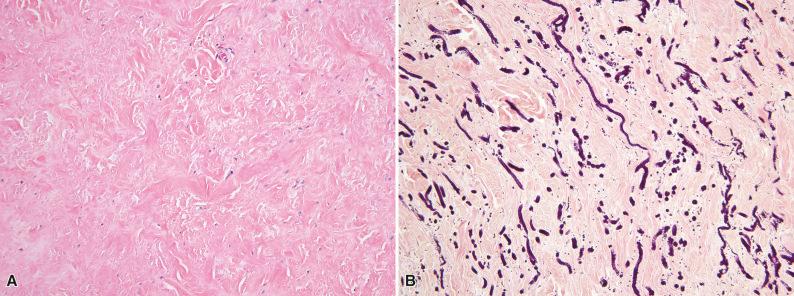
The spindle cells are occasionally positive for smooth muscle actin but negative for desmin, CD34, and S-100 protein. Elastic fibers can be highlighted by special stains (e.g., Verhoeff-van Gieson stain; see Fig. 3.23B ).
The diagnosis of elastofibroma is generally straightforward for a tumor arising on the lower aspect of the scapula, after the characteristic elastic fibers are identified. Desmoplastic fibroblastoma may occasionally be considered, but the typical stellate fibroblasts and lack of fragmented elastic fibers help distinguish this tumor type.
Elastofibroma is benign and does not recur. Simple excision is curative.
Calcifying fibrous tumor (previously known as calcifying fibrous pseudotumor) is a paucicellular fibroblastic proliferation that usually affects children and young adults. It occurs as a long-standing painless mass in the deep soft tissues or in body cavities, often involving peritoneum or pleura. A substantial subset of cases is multifocal at diagnosis. This tumor has previously been interpreted as either reactive in nature or as a late “burned-out” stage of inflammatory myofibroblastic tumor, but currently most authors regard it as a distinct fibroblastic neoplasm.
Calcifying fibrous tumor is a firm, well-circumscribed, sometimes lobulated hypocellular lesion composed of dense stromal collagen with psammomatous and dystrophic calcifications and a patchy chronic inflammatory infiltrate ( Fig. 3.24 ). It contains only very few scattered spindled fibroblasts with bland nuclear morphology (see Fig. 3.24B ). Most tumors are positive for CD34, occasionally with scattered cells expressing smooth muscle actin and desmin, and ALK and S-100 protein are consistently negative.
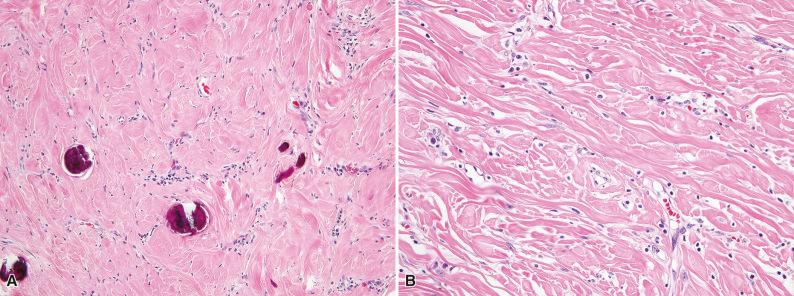
Calcifying fibrous tumor is a benign lesion with a low risk of recurrence and no metastatic potential.
Angiofibroma of soft tissue is a benign soft tissue tumor that is clinically and pathologically distinct from cellular angiofibroma (see Chapter 17 ) and nasopharyngeal angiofibroma (see Chapter 4 ).
Angiofibroma of soft tissue occurs over a wide age range and affects females twice as frequently as males. The tumor most often occurs as a slowly growing painless mass located in the soft tissues of the extremities, mainly the legs, often adjacent to joints or fibrotendinous structures. The tumors may be subcutaneous or deep seated. Unusual anatomic locations include the back, abdominal wall, pelvic cavity, and breast.
Preoperative duration is usually long, up to several years. Most lesions are well circumscribed; however, in some cases, infiltration into adjacent structures (including intraarticular extension) may be detected on imaging. Such findings, combined with the hypervascularity of the lesion, may occasionally raise clinical concerns for malignancy and result in significant overtreatment.
Histologically, angiofibroma of soft tissue is composed of relatively uniform bland spindle cells set in a variably myxoid-to-collagenous stroma with a prominent and complex vascular pattern ( Fig. 3.25 ). The tumor is generally well circumscribed but unencapsulated, although focal infiltration of the adjacent soft tissues may be present. The tumors are vaguely lobulated, with alternating myxoid and collagenous areas and regional variation in cellularity. Focal degenerative changes such as ischemic necrosis and edema may be present, perhaps reflecting long preoperative duration. The prominent blood vessels in soft tissue angiofibroma are of variable size and shape. Innumerable small thin-walled branching blood vessels are evenly distributed throughout the lesion, somewhat reminiscent of those seen in myxoid liposarcoma, although larger and even more numerous (see Fig. 3.25B ). In addition, less prominent medium-sized or large blood vessels with variably thick walls are noticeable in most tumors; in some instances, these are rounded, occasionally slitlike, but most often with ectatic lumina and staghorn (HPC-like) morphology, resembling the vessels in SFT (see Fig. 3.25C ). These larger vessels tend to be located at the periphery of the tumor. Common additional features include collagen deposition around blood vessels and marked hyalinization or fibrinoid necrosis of medium-sized vessel walls.

The cytomorphology of the lesional spindle cells is nondistinctive, with inconspicuous palely eosinophilic cytoplasm and short ovoid or more tapering nuclei, with irregular nuclear contours and fine chromatin with inconspicuous to small nucleoli (see Fig. 3.25D ). Cytologic atypia and nuclear hyperchromasia are absent. Mitotic activity is generally low (<5 per 10 HPF).
There is usually some variation in the tumor stroma, ranging from a loosely myxoid matrix transitioning smoothly into areas of deposition of fine fibrillary or coarsely banded collagen. In some cases, myxoid tumor lobules are sharply demarcated with more abrupt transition to collagenous areas. A variably dense inflammatory infiltrate, comprising mainly small lymphocytes, some mast cells, and occasional neutrophils and plasma cells, is usually noted, sometimes in a perivascular distribution.
Immunohistochemistry does not play a significant role in the diagnosis of angiofibroma of soft tissue. The tumor cells express EMA in 50% of cases, usually focally but sometimes diffusely. CD34, smooth muscle actin, and desmin may also be focally detected. Tumor cells are negative for S-100 protein.
Soft tissue angiofibroma is characterized by a simple karyotype, usually with a t(5;8)(p15;q12) translocation, resulting in an AHRR-NCOA2 fusion gene. This fusion gene seems to be specific for angiofibroma of soft tissue and may be a useful aid for diagnosis. Alternative gene fusions include GTF2I-NCOA2 , emphasizing the relevance of NCOA2 in the development of soft tissue angiofibroma. Detection of NCOA2 rearrangements by FISH may be diagnostically useful, but it should be interpreted with caution, given the involvement of this gene in other spindle cell tumors.
The differential diagnosis includes a range of benign and low-grade malignant soft tissue tumors, such as cellular angiofibroma, SFT, LGFMS, low-grade myxofibrosarcoma, and myxoid liposarcoma. Other diagnoses that may be considered in more myxoid examples include cellular myxoma and superficial angiomyxoma.
Cellular angiofibroma occurs nearly exclusively in the pelviperineal region and contains more rounded blood vessels. It is usually more uniformly cellular, with short stubby spindle cells resembling those in spindle cell lipoma (see Chapter 17 ). SFT shows a “patternless” architecture, with pronounced variation in cellularity, prominent thick collagen bundles, and characteristic branching staghorn vessels, which are not accompanied by the abundant smaller vessels typical of angiofibroma of soft tissue. STAT6 expression is specific for SFT in this differential diagnosis.
LGFMS shows alternating collagenous and myxoid areas that may resemble some cases of angiofibroma of soft tissue; however, there is usually a more whorled growth pattern, and the tumors tend to be more uniformly hypocellular. In addition, although LGFMS may contain arcades of thin-walled vessels, vascularity is usually not prominent. Immunohistochemical detection of MUC4 expression or demonstration of FUS gene rearrangement can help confirm the diagnosis of LGFMS.
Myxofibrosarcoma shows distinctive histologic features, including a lobulated growth pattern with infiltrative margins and tumor cells with hyperchromatic atypical or pleomorphic nuclei. Obvious cytologic features of malignancy are usually present, and the characteristic curvilinear vessels with perivascular hypercellularity bear no resemblance to the rich vascular network of angiofibroma of soft tissue. Myxoid liposarcoma contains a prominent plexiform network of thin-walled capillaries, but even the smallest vessels in angiofibroma have thicker walls and are more numerous than the delicate capillaries of myxoid liposarcoma. These differences, in addition to the less abundant myxoid stroma and the absence of lipoblasts in angiofibroma of soft tissue, allow distinction between these tumor types.
Become a Clinical Tree membership for Full access and enjoy Unlimited articles
If you are a member. Log in here